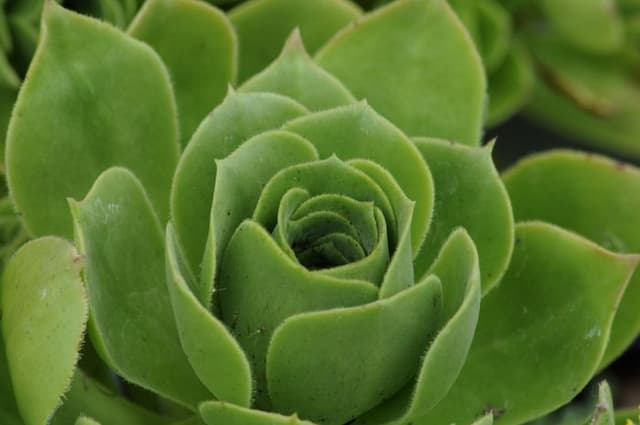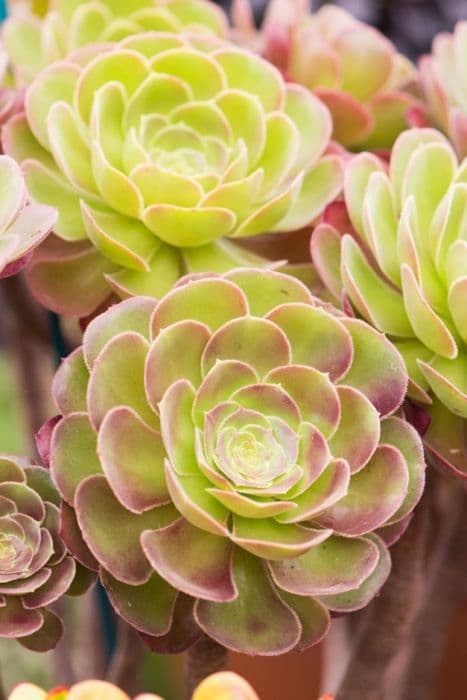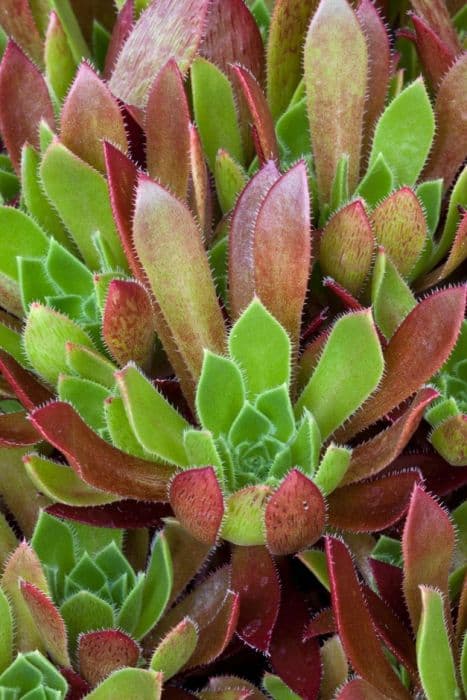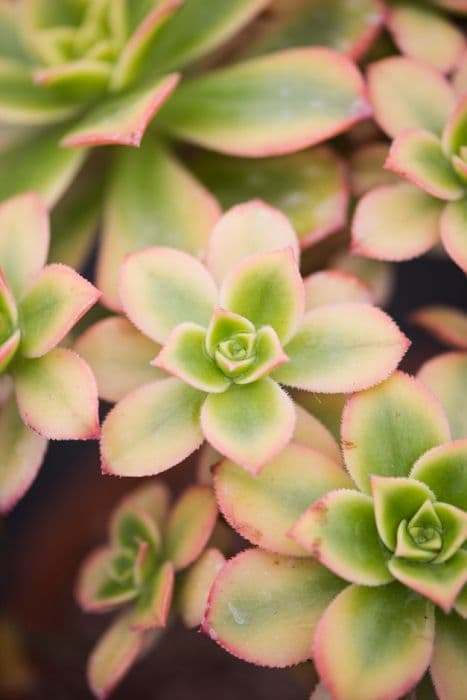Stonecrop Hylotelephium 'Joyce Henderson'

ABOUT
Joyce Henderson is a perennial plant known for its striking appearance and easy care. It features fleshy, spoon-shaped leaves that grow in a whorled pattern, creating a densely packed, bushy appearance. The leaves are often a glaucous green color with hints of blue or purple, adding to its visual interest. As the growing season progresses, Joyce Henderson produces clusters of star-shaped flowers that bloom in a vibrant shade often described as a rosy pink or deep mauve. These flowers are tightly packed together in flat-topped clusters, which rise above the foliage on sturdy stems, creating a showy display that can attract pollinators like bees and butterflies. The contrast between the flowers and the foliage, along with the texture of the leaves, makes Joyce Henderson a popular choice for gardeners looking to add both color and texture to their landscapes.
About this plant
 Names
NamesFamily
Crassulaceae
Synonyms
Joyce Henderson Stonecrop, Joyce Henderson Sedum
Common names
Sedum telephium 'Joyce Henderson', Hylotelephium telephium 'Joyce Henderson'.
 Toxicity
ToxicityTo humans
The Hylotelephium 'Joyce Henderson', commonly known as Stonecrop, is not widely known to be toxic to humans. However, it is generally recommended to avoid ingesting parts of ornamental plants as they may cause digestive upset or allergic reactions in some individuals. If ingested, minor symptoms such as nausea, vomiting, or diarrhea might occur.
To pets
Stonecrop is generally considered to be of low toxicity to pets. However, if ingested in large amounts, it may cause mild gastrointestinal upset such as vomiting or diarrhea in some animals. Always monitor your pet's behavior after ingestion and consult with a veterinarian if any concerning symptoms arise.
 Characteristics
CharacteristicsLife cycle
Perennials
Foliage type
Deciduous
Color of leaves
Green
Flower color
Pink
Height
1-2 feet (30-60 cm)
Spread
1-2 feet (30-60 cm)
Plant type
Succulent
Hardiness zones
3-9
Native area
Asia
Benefits
 General Benefits
General Benefits- Easy to Grow: 'Joyce Henderson' is known for being low-maintenance and easy to cultivate, making it suitable for gardeners of all skill levels.
- Drought Tolerant: Once established, this plant has excellent drought resistance, requiring minimal watering and conserving water resources.
- Attracts Pollinators: Blooms attract bees, butterflies, and other beneficial insects, supporting local ecosystems.
- Seasonal Interest: Offers vibrant flowers and foliage that contribute to the aesthetic appeal of gardens throughout the growing season.
- Versatile Landscaping: Can be used in rock gardens, borders, and as groundcover, offering diverse landscaping options.
- Cold Hardy: Adapts well to cooler climates and can survive frost, making it a robust choice for different gardening zones.
- Long Blooming Season: Flowers for an extended period, providing long-lasting color and interest in the landscape.
- Low Fertilizer Needs: Generally requires little to no fertilizing, which simplifies care and reduces chemical use.
- Pest Resistance: Typically resistant to pests, helping to minimize the need for pesticide use and maintenance.
- Propagates Easily: Can be easily propagated from cuttings or leaves, allowing gardeners to expand their gardens or share with others.
 Medical Properties
Medical PropertiesThis plant is not used for medical purposes.
 Air-purifying Qualities
Air-purifying QualitiesThis plant is not specifically known for air purifying qualities.
 Other Uses
Other Uses- Sedum 'Joyce Henderson' can be used in fairy gardens due to its small stature and attractive foliage, creating a whimsical, miniature landscape.
- The plant's dense growth can serve as a living mulch, reducing the need for additional mulching materials in the garden.
- Foliage from Sedum 'Joyce Henderson' can be used in floral arrangements for texture and interest, either fresh or dried.
- Sedum 'Joyce Henderson' can be grown in hanging baskets where its trailing habit can be showcased effectively.
- The plant can be used in green roofing projects, as it is tolerant of harsh conditions and requires minimal maintenance.
- Sedum 'Joyce Henderson' can be used to create a low-maintenance, textured groundcover in xeriscaping designs.
- Its ability to thrive in rocky and sandy soils makes it a good candidate for coastal gardens where other plants may struggle.
- These plants can be used in outdoor container gardens, where they can survive with less frequent watering compared to other species.
- Sedum 'Joyce Henderson' can serve as a natural weed barrier due to its dense growth habit, reducing the prevalence of unwanted plants.
- The contrasting colors of its leaves and flowers can be used to create visual interest in rock gardens, where it can complement stones and other alpine plants.
Interesting Facts
 Feng Shui
Feng ShuiThe Stonecrop is not used in Feng Shui practice.
 Zodiac Sign Compitability
Zodiac Sign CompitabilityThe Stonecrop is not used in astrology practice.
 Plant Symbolism
Plant Symbolism- Resilience - Joyce Henderson, commonly referred to as Stonecrop, is known for its hardy nature and ability to thrive in tough conditions, symbolizing the human capacity to persevere through challenges.
- Survival - As a succulent, Stonecrop has the ability to store water in its leaves, symbolizing the ability to survive and adapt in different environments and situations.
- Timelessness - The perennial nature of Stonecrop, which allows it to come back year after year, can be seen as symbolizing everlasting or enduring qualities, such as love or friendship.
 Water
WaterFor Stonecrop 'Joyce Henderson', water the plant deeply but infrequently to mimic natural drought conditions, allowing the soil to dry out completely between waterings. Typically, this means watering approximately once every two weeks during the growing season, but this can vary depending on climate and weather conditions. Provide about one inch of water (or about half a gallon for an average pot size) each time you water. During the winter, reduce watering to once per month or less, as the plant enters a dormancy period and requires less moisture.
 Light
LightStonecrop 'Joyce Henderson' thrives in full sun to partial shade. The ideal spot for this plant is an area where it can receive at least six hours of direct sunlight each day, although it can tolerate some light shade, especially in hotter climates. Avoid deep shade locations, as inadequate light can lead to etiolation and reduced flowering.
 Temperature
TemperatureStonecrop 'Joyce Henderson' prefers temperature conditions between 65 to 75 degrees Fahrenheit but can withstand temperatures as low as 30 degrees Fahrenheit and as high as 90 degrees Fahrenheit without significant damage. The plant is quite hardy and can survive the occasional dip below freezing, but prolonged exposure to extreme cold or heat should be avoided.
 Pruning
PruningStonecrop 'Joyce Henderson' benefits from pruning to maintain its shape, encourage fuller growth, and remove dead or damaged stems. Prune in late winter or early spring before new growth begins. Cutting back spent flower heads after blooming can also promote a second flush of flowers. Typically, annual pruning is enough to keep the plant healthy and attractive.
 Cleaning
CleaningAs needed
 Soil
SoilThe best soil mix for the Autumn Joy Sedum is a well-draining, sandy or gravelly soil with a slightly acidic to neutral pH of around 6.0-7.5. A mixture containing one part garden soil, one part coarse sand or perlite, and one part compost or peat moss is ideal for facilitating proper drainage and ensuring the roots are not waterlogged.
 Repotting
RepottingAutumn Joy Sedum should be repotted every two to three years to provide fresh soil and more room for growth. This plant is relatively low-maintenance but may benefit from repotting when it becomes root-bound or the soil quality deteriorates.
 Humidity & Misting
Humidity & MistingAutumn Joy Sedum prefers average to dry humidity conditions. It thrives in an environment that is not too humid, as excessive moisture in the air can lead to fungal issues or rot.
 Suitable locations
Suitable locationsIndoor
Place in bright light, minimal water.
Outdoor
Plant in full sun, well-drained soil.
Hardiness zone
3-9 USDA
 Life cycle
Life cycleHylotelephium 'Joyce Henderson', commonly known as the 'Joyce Henderson' Stonecrop, begins its life as a seed, which, when sown in well-draining soil and exposed to the right temperature conditions, germinates. During the growth stage, it develops succulent leaves and a strong stem, forming a rosette-like structure and continues to mature, thriving in full sun and requiring minimal water due to its drought-resistant nature. As it reaches maturity, usually in late summer to early fall, it produces clusters of star-shaped flowers, often attracting bees and butterflies. After blooming, the flowers gradually wither, and the plant may produce seeds, which can be dispersed to start the next generation. During the cold season, the plant may die back, especially in colder climates; however, it is a perennial and will regrow from its root system when favorable conditions return in spring. With good care, 'Joyce Henderson' Stonecrop can live for several years, repeating this cycle annually.
 Propogation
PropogationPropogation time
Late summer to autumn
Hylotelephium 'Joyce Henderson', commonly known as Stonecrop, can be propagated most effectively through the division of its clumps. This process is best performed in early spring as the plant emerges from dormancy. To propagate by division, carefully dig up an established clump of Stonecrop, making sure to get a good amount of the root system. Using a sharp knife or spade, divide the clump into smaller sections, each with a portion of roots attached. These sections can then be immediately replanted into a well-draining soil mix, spaced about 12 inches (approximately 30 centimeters) apart to give them room to grow. Water the new divisions gently to settle the soil around the roots, and keep the soil moist but not waterlogged as they establish. This method of propagation is simple and helps to invigorate older plants while expanding the garden with new plants.









